Business Law and Ethics Report: Contract Law, Court System, Remedies
VerifiedAdded on 2022/12/30
|8
|1969
|29
Report
AI Summary
This report delves into the realm of business law and ethics, providing a comprehensive analysis of contract law, the English legal system, and available remedies. It begins by defining contract law and outlining the essential elements of a contract, including offer, acceptance, intention to create legal relations, and consideration. The report then explains the structure of the English court system, differentiating between superior and subordinate courts, and advising parties on the appropriate court for pursuing legal action. Furthermore, it assesses the existence of binding contracts in three case scenarios involving Hilary, Eleanor, Amy, and Olivia, applying legal principles to determine contractual obligations. Finally, the report explores various remedies for breach of contract, such as damages, specific performance, injunctions, and repudiation. This report offers a thorough examination of key legal concepts and their practical application in business scenarios.
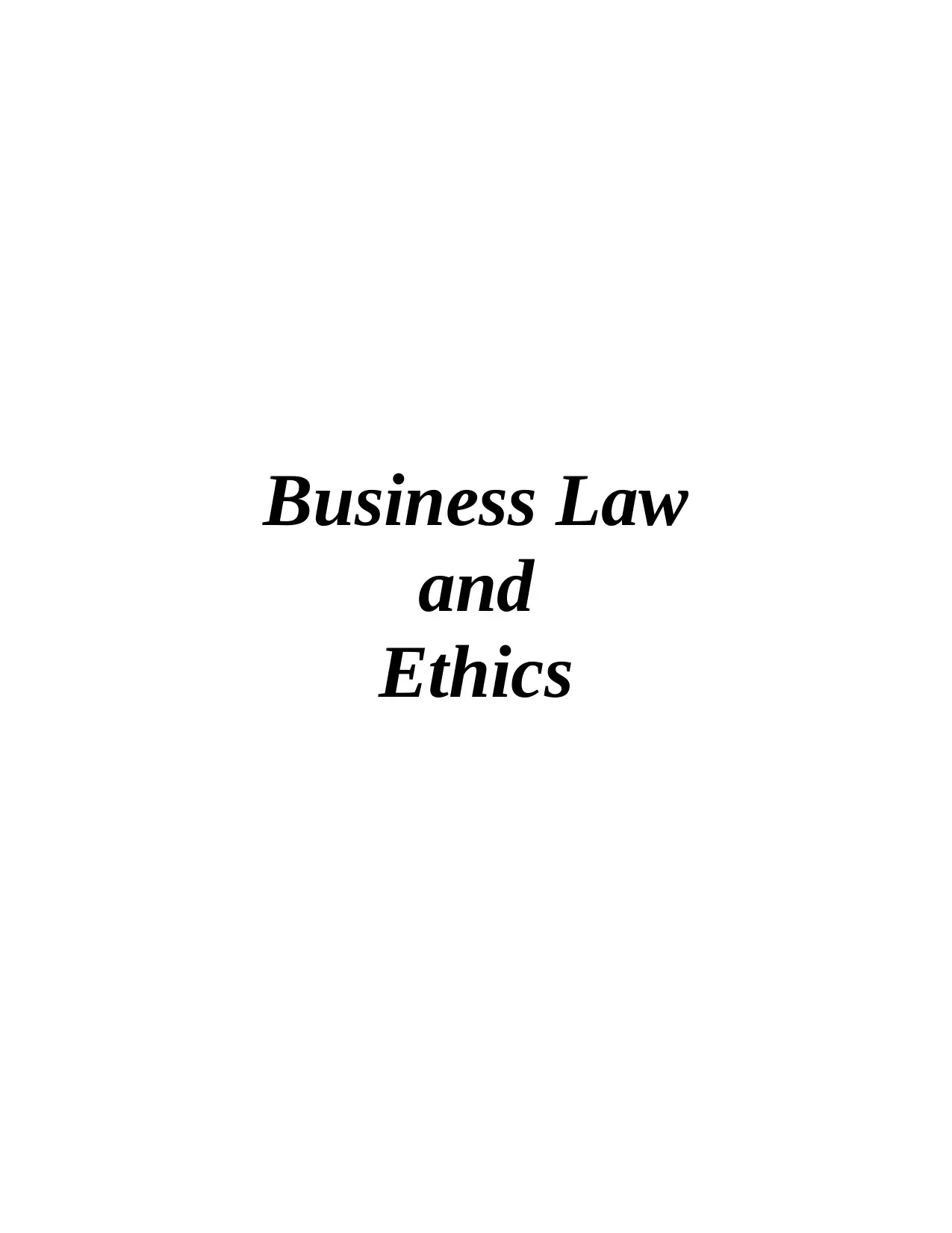
Business Law
and
Ethics
and
Ethics
Paraphrase This Document
Need a fresh take? Get an instant paraphrase of this document with our AI Paraphraser

Table of Contents
INTRODUCTION ..........................................................................................................................3
TASK ..............................................................................................................................................3
Define contract law and describe all the blue prints of a contract..............................................3
Explain the court system in relation to the English legal system and advise the parties above
which court(s) action to pursue...................................................................................................4
Advise Hilary as to whether binding contracts exist between herself and each of the following
people: Eleanor, Amy and Olivia. ..............................................................................................5
Explain and discuss the various remedies available to the parties..............................................6
CONCLUSION ...............................................................................................................................7
REFERENCES................................................................................................................................8
INTRODUCTION ..........................................................................................................................3
TASK ..............................................................................................................................................3
Define contract law and describe all the blue prints of a contract..............................................3
Explain the court system in relation to the English legal system and advise the parties above
which court(s) action to pursue...................................................................................................4
Advise Hilary as to whether binding contracts exist between herself and each of the following
people: Eleanor, Amy and Olivia. ..............................................................................................5
Explain and discuss the various remedies available to the parties..............................................6
CONCLUSION ...............................................................................................................................7
REFERENCES................................................................................................................................8
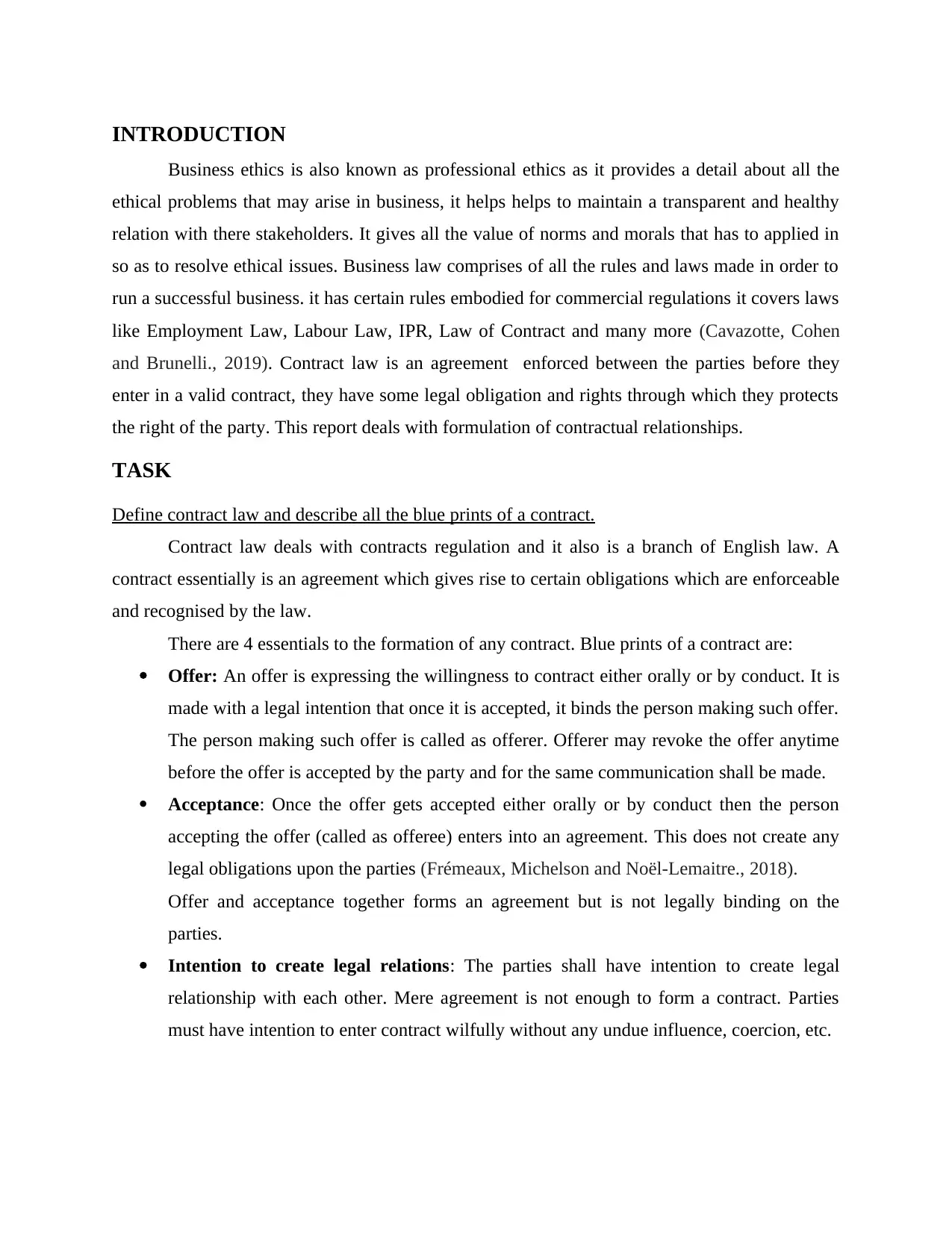
INTRODUCTION
Business ethics is also known as professional ethics as it provides a detail about all the
ethical problems that may arise in business, it helps helps to maintain a transparent and healthy
relation with there stakeholders. It gives all the value of norms and morals that has to applied in
so as to resolve ethical issues. Business law comprises of all the rules and laws made in order to
run a successful business. it has certain rules embodied for commercial regulations it covers laws
like Employment Law, Labour Law, IPR, Law of Contract and many more (Cavazotte, Cohen
and Brunelli., 2019). Contract law is an agreement enforced between the parties before they
enter in a valid contract, they have some legal obligation and rights through which they protects
the right of the party. This report deals with formulation of contractual relationships.
TASK
Define contract law and describe all the blue prints of a contract.
Contract law deals with contracts regulation and it also is a branch of English law. A
contract essentially is an agreement which gives rise to certain obligations which are enforceable
and recognised by the law.
There are 4 essentials to the formation of any contract. Blue prints of a contract are:
Offer: An offer is expressing the willingness to contract either orally or by conduct. It is
made with a legal intention that once it is accepted, it binds the person making such offer.
The person making such offer is called as offerer. Offerer may revoke the offer anytime
before the offer is accepted by the party and for the same communication shall be made.
Acceptance: Once the offer gets accepted either orally or by conduct then the person
accepting the offer (called as offeree) enters into an agreement. This does not create any
legal obligations upon the parties (Frémeaux, Michelson and Noël-Lemaitre., 2018).
Offer and acceptance together forms an agreement but is not legally binding on the
parties.
Intention to create legal relations: The parties shall have intention to create legal
relationship with each other. Mere agreement is not enough to form a contract. Parties
must have intention to enter contract wilfully without any undue influence, coercion, etc.
Business ethics is also known as professional ethics as it provides a detail about all the
ethical problems that may arise in business, it helps helps to maintain a transparent and healthy
relation with there stakeholders. It gives all the value of norms and morals that has to applied in
so as to resolve ethical issues. Business law comprises of all the rules and laws made in order to
run a successful business. it has certain rules embodied for commercial regulations it covers laws
like Employment Law, Labour Law, IPR, Law of Contract and many more (Cavazotte, Cohen
and Brunelli., 2019). Contract law is an agreement enforced between the parties before they
enter in a valid contract, they have some legal obligation and rights through which they protects
the right of the party. This report deals with formulation of contractual relationships.
TASK
Define contract law and describe all the blue prints of a contract.
Contract law deals with contracts regulation and it also is a branch of English law. A
contract essentially is an agreement which gives rise to certain obligations which are enforceable
and recognised by the law.
There are 4 essentials to the formation of any contract. Blue prints of a contract are:
Offer: An offer is expressing the willingness to contract either orally or by conduct. It is
made with a legal intention that once it is accepted, it binds the person making such offer.
The person making such offer is called as offerer. Offerer may revoke the offer anytime
before the offer is accepted by the party and for the same communication shall be made.
Acceptance: Once the offer gets accepted either orally or by conduct then the person
accepting the offer (called as offeree) enters into an agreement. This does not create any
legal obligations upon the parties (Frémeaux, Michelson and Noël-Lemaitre., 2018).
Offer and acceptance together forms an agreement but is not legally binding on the
parties.
Intention to create legal relations: The parties shall have intention to create legal
relationship with each other. Mere agreement is not enough to form a contract. Parties
must have intention to enter contract wilfully without any undue influence, coercion, etc.
⊘ This is a preview!⊘
Do you want full access?
Subscribe today to unlock all pages.

Trusted by 1+ million students worldwide
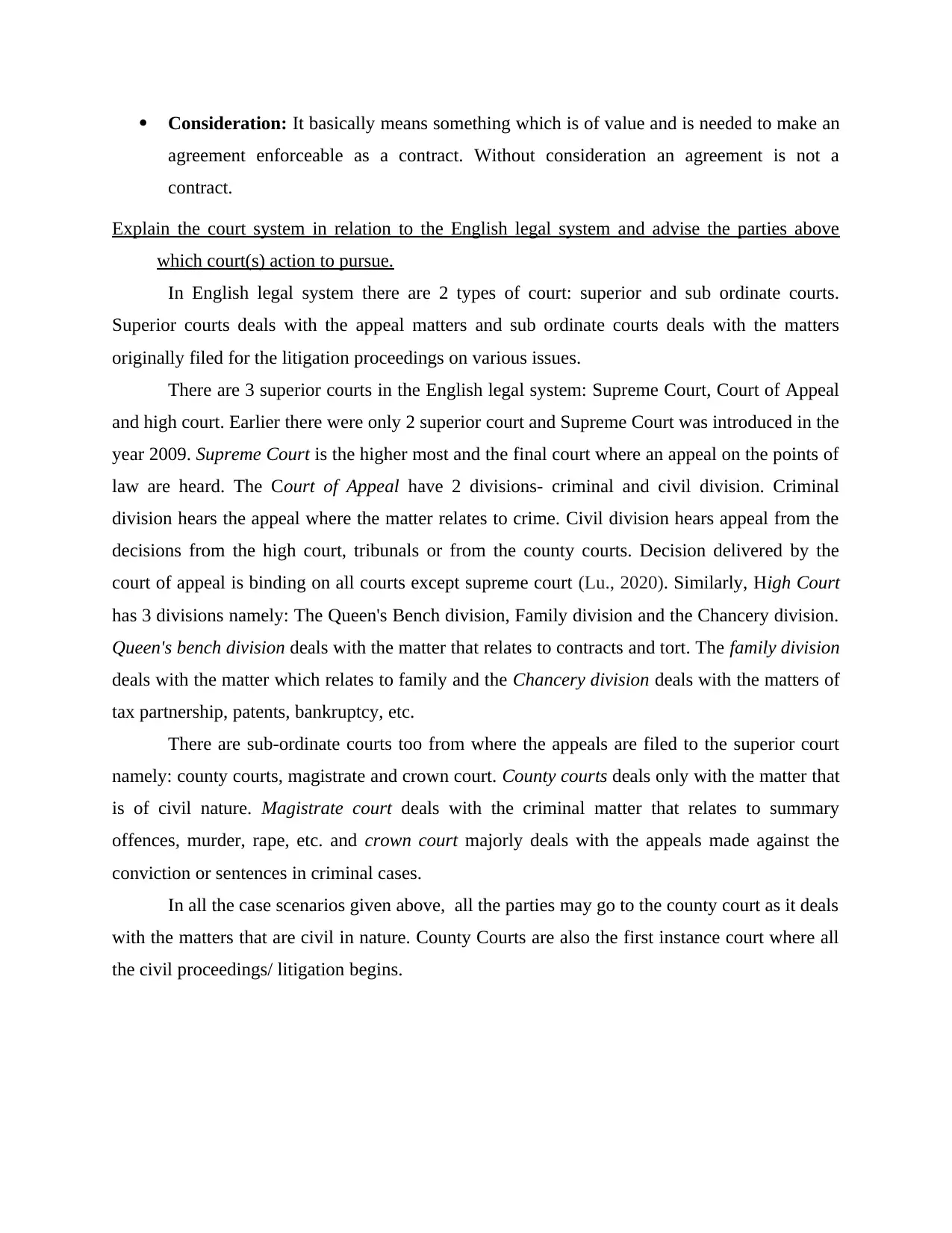
Consideration: It basically means something which is of value and is needed to make an
agreement enforceable as a contract. Without consideration an agreement is not a
contract.
Explain the court system in relation to the English legal system and advise the parties above
which court(s) action to pursue.
In English legal system there are 2 types of court: superior and sub ordinate courts.
Superior courts deals with the appeal matters and sub ordinate courts deals with the matters
originally filed for the litigation proceedings on various issues.
There are 3 superior courts in the English legal system: Supreme Court, Court of Appeal
and high court. Earlier there were only 2 superior court and Supreme Court was introduced in the
year 2009. Supreme Court is the higher most and the final court where an appeal on the points of
law are heard. The Court of Appeal have 2 divisions- criminal and civil division. Criminal
division hears the appeal where the matter relates to crime. Civil division hears appeal from the
decisions from the high court, tribunals or from the county courts. Decision delivered by the
court of appeal is binding on all courts except supreme court (Lu., 2020). Similarly, High Court
has 3 divisions namely: The Queen's Bench division, Family division and the Chancery division.
Queen's bench division deals with the matter that relates to contracts and tort. The family division
deals with the matter which relates to family and the Chancery division deals with the matters of
tax partnership, patents, bankruptcy, etc.
There are sub-ordinate courts too from where the appeals are filed to the superior court
namely: county courts, magistrate and crown court. County courts deals only with the matter that
is of civil nature. Magistrate court deals with the criminal matter that relates to summary
offences, murder, rape, etc. and crown court majorly deals with the appeals made against the
conviction or sentences in criminal cases.
In all the case scenarios given above, all the parties may go to the county court as it deals
with the matters that are civil in nature. County Courts are also the first instance court where all
the civil proceedings/ litigation begins.
agreement enforceable as a contract. Without consideration an agreement is not a
contract.
Explain the court system in relation to the English legal system and advise the parties above
which court(s) action to pursue.
In English legal system there are 2 types of court: superior and sub ordinate courts.
Superior courts deals with the appeal matters and sub ordinate courts deals with the matters
originally filed for the litigation proceedings on various issues.
There are 3 superior courts in the English legal system: Supreme Court, Court of Appeal
and high court. Earlier there were only 2 superior court and Supreme Court was introduced in the
year 2009. Supreme Court is the higher most and the final court where an appeal on the points of
law are heard. The Court of Appeal have 2 divisions- criminal and civil division. Criminal
division hears the appeal where the matter relates to crime. Civil division hears appeal from the
decisions from the high court, tribunals or from the county courts. Decision delivered by the
court of appeal is binding on all courts except supreme court (Lu., 2020). Similarly, High Court
has 3 divisions namely: The Queen's Bench division, Family division and the Chancery division.
Queen's bench division deals with the matter that relates to contracts and tort. The family division
deals with the matter which relates to family and the Chancery division deals with the matters of
tax partnership, patents, bankruptcy, etc.
There are sub-ordinate courts too from where the appeals are filed to the superior court
namely: county courts, magistrate and crown court. County courts deals only with the matter that
is of civil nature. Magistrate court deals with the criminal matter that relates to summary
offences, murder, rape, etc. and crown court majorly deals with the appeals made against the
conviction or sentences in criminal cases.
In all the case scenarios given above, all the parties may go to the county court as it deals
with the matters that are civil in nature. County Courts are also the first instance court where all
the civil proceedings/ litigation begins.
Paraphrase This Document
Need a fresh take? Get an instant paraphrase of this document with our AI Paraphraser
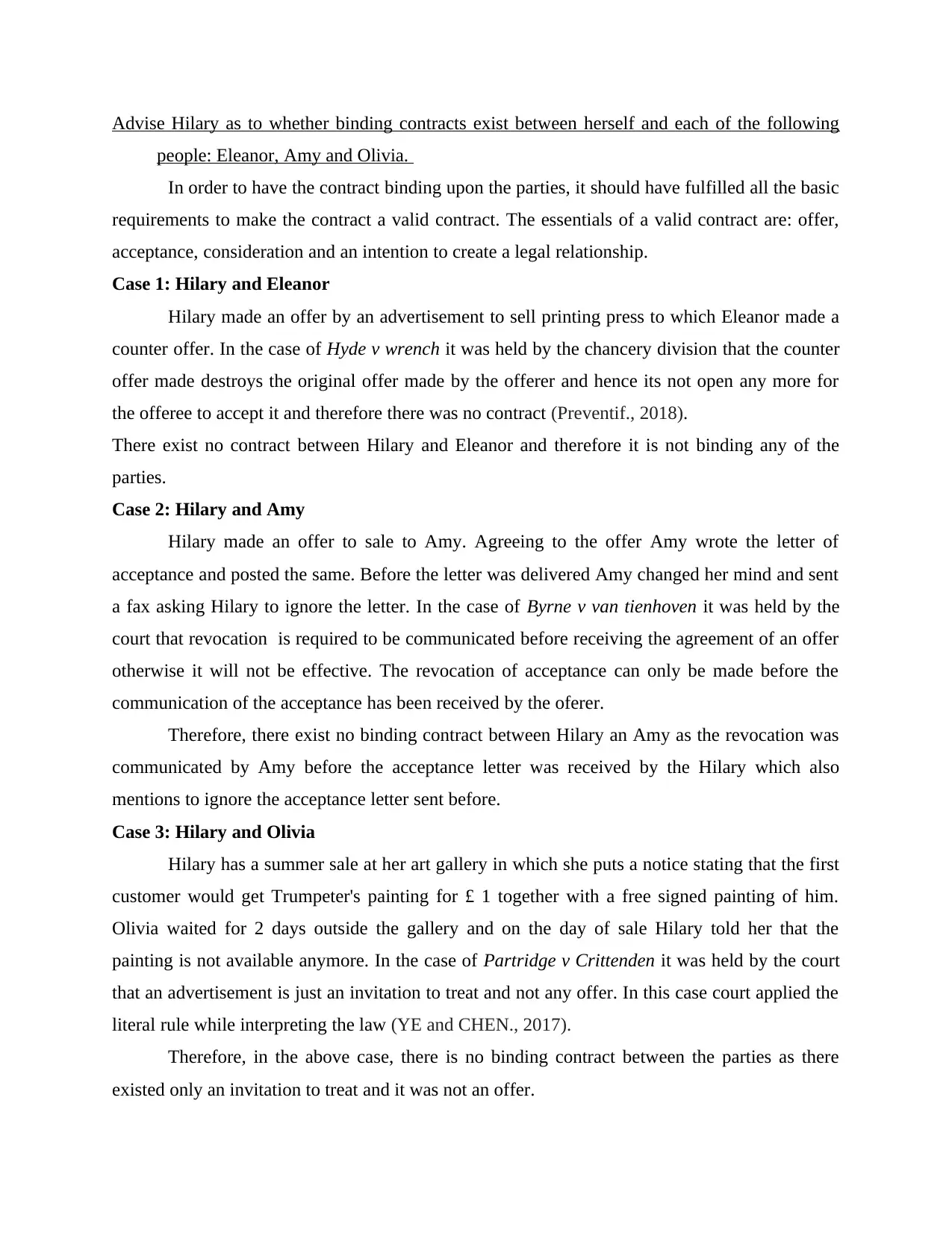
Advise Hilary as to whether binding contracts exist between herself and each of the following
people: Eleanor, Amy and Olivia.
In order to have the contract binding upon the parties, it should have fulfilled all the basic
requirements to make the contract a valid contract. The essentials of a valid contract are: offer,
acceptance, consideration and an intention to create a legal relationship.
Case 1: Hilary and Eleanor
Hilary made an offer by an advertisement to sell printing press to which Eleanor made a
counter offer. In the case of Hyde v wrench it was held by the chancery division that the counter
offer made destroys the original offer made by the offerer and hence its not open any more for
the offeree to accept it and therefore there was no contract (Preventif., 2018).
There exist no contract between Hilary and Eleanor and therefore it is not binding any of the
parties.
Case 2: Hilary and Amy
Hilary made an offer to sale to Amy. Agreeing to the offer Amy wrote the letter of
acceptance and posted the same. Before the letter was delivered Amy changed her mind and sent
a fax asking Hilary to ignore the letter. In the case of Byrne v van tienhoven it was held by the
court that revocation is required to be communicated before receiving the agreement of an offer
otherwise it will not be effective. The revocation of acceptance can only be made before the
communication of the acceptance has been received by the oferer.
Therefore, there exist no binding contract between Hilary an Amy as the revocation was
communicated by Amy before the acceptance letter was received by the Hilary which also
mentions to ignore the acceptance letter sent before.
Case 3: Hilary and Olivia
Hilary has a summer sale at her art gallery in which she puts a notice stating that the first
customer would get Trumpeter's painting for £ 1 together with a free signed painting of him.
Olivia waited for 2 days outside the gallery and on the day of sale Hilary told her that the
painting is not available anymore. In the case of Partridge v Crittenden it was held by the court
that an advertisement is just an invitation to treat and not any offer. In this case court applied the
literal rule while interpreting the law (YE and CHEN., 2017).
Therefore, in the above case, there is no binding contract between the parties as there
existed only an invitation to treat and it was not an offer.
people: Eleanor, Amy and Olivia.
In order to have the contract binding upon the parties, it should have fulfilled all the basic
requirements to make the contract a valid contract. The essentials of a valid contract are: offer,
acceptance, consideration and an intention to create a legal relationship.
Case 1: Hilary and Eleanor
Hilary made an offer by an advertisement to sell printing press to which Eleanor made a
counter offer. In the case of Hyde v wrench it was held by the chancery division that the counter
offer made destroys the original offer made by the offerer and hence its not open any more for
the offeree to accept it and therefore there was no contract (Preventif., 2018).
There exist no contract between Hilary and Eleanor and therefore it is not binding any of the
parties.
Case 2: Hilary and Amy
Hilary made an offer to sale to Amy. Agreeing to the offer Amy wrote the letter of
acceptance and posted the same. Before the letter was delivered Amy changed her mind and sent
a fax asking Hilary to ignore the letter. In the case of Byrne v van tienhoven it was held by the
court that revocation is required to be communicated before receiving the agreement of an offer
otherwise it will not be effective. The revocation of acceptance can only be made before the
communication of the acceptance has been received by the oferer.
Therefore, there exist no binding contract between Hilary an Amy as the revocation was
communicated by Amy before the acceptance letter was received by the Hilary which also
mentions to ignore the acceptance letter sent before.
Case 3: Hilary and Olivia
Hilary has a summer sale at her art gallery in which she puts a notice stating that the first
customer would get Trumpeter's painting for £ 1 together with a free signed painting of him.
Olivia waited for 2 days outside the gallery and on the day of sale Hilary told her that the
painting is not available anymore. In the case of Partridge v Crittenden it was held by the court
that an advertisement is just an invitation to treat and not any offer. In this case court applied the
literal rule while interpreting the law (YE and CHEN., 2017).
Therefore, in the above case, there is no binding contract between the parties as there
existed only an invitation to treat and it was not an offer.
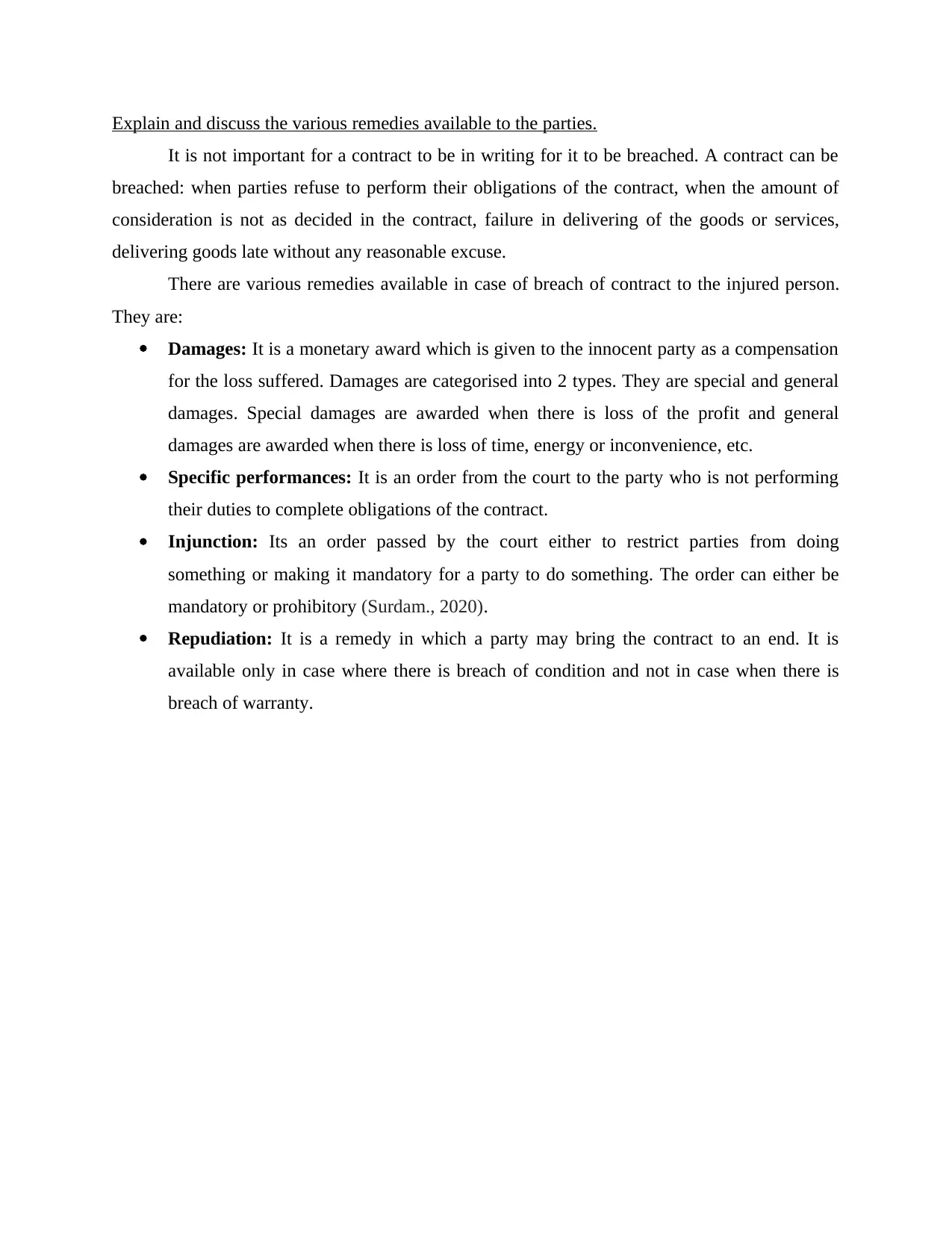
Explain and discuss the various remedies available to the parties.
It is not important for a contract to be in writing for it to be breached. A contract can be
breached: when parties refuse to perform their obligations of the contract, when the amount of
consideration is not as decided in the contract, failure in delivering of the goods or services,
delivering goods late without any reasonable excuse.
There are various remedies available in case of breach of contract to the injured person.
They are:
Damages: It is a monetary award which is given to the innocent party as a compensation
for the loss suffered. Damages are categorised into 2 types. They are special and general
damages. Special damages are awarded when there is loss of the profit and general
damages are awarded when there is loss of time, energy or inconvenience, etc.
Specific performances: It is an order from the court to the party who is not performing
their duties to complete obligations of the contract.
Injunction: Its an order passed by the court either to restrict parties from doing
something or making it mandatory for a party to do something. The order can either be
mandatory or prohibitory (Surdam., 2020).
Repudiation: It is a remedy in which a party may bring the contract to an end. It is
available only in case where there is breach of condition and not in case when there is
breach of warranty.
It is not important for a contract to be in writing for it to be breached. A contract can be
breached: when parties refuse to perform their obligations of the contract, when the amount of
consideration is not as decided in the contract, failure in delivering of the goods or services,
delivering goods late without any reasonable excuse.
There are various remedies available in case of breach of contract to the injured person.
They are:
Damages: It is a monetary award which is given to the innocent party as a compensation
for the loss suffered. Damages are categorised into 2 types. They are special and general
damages. Special damages are awarded when there is loss of the profit and general
damages are awarded when there is loss of time, energy or inconvenience, etc.
Specific performances: It is an order from the court to the party who is not performing
their duties to complete obligations of the contract.
Injunction: Its an order passed by the court either to restrict parties from doing
something or making it mandatory for a party to do something. The order can either be
mandatory or prohibitory (Surdam., 2020).
Repudiation: It is a remedy in which a party may bring the contract to an end. It is
available only in case where there is breach of condition and not in case when there is
breach of warranty.
⊘ This is a preview!⊘
Do you want full access?
Subscribe today to unlock all pages.

Trusted by 1+ million students worldwide

CONCLUSION
Contract law is that law which deals with the regulations of the contracts. There are 4
essentials of a contract to make it legally binding and enforceable by law, they are: offer,
acceptance, intention to create legal relationship and consideration. In case there is any breach of
contract there are several remedies which are given to the innocent party, they are: damages,
specific performances, injunction and repudiation. There are 3 case scenarios given and in none
of the cases given there is breach of contract.
Contract law is that law which deals with the regulations of the contracts. There are 4
essentials of a contract to make it legally binding and enforceable by law, they are: offer,
acceptance, intention to create legal relationship and consideration. In case there is any breach of
contract there are several remedies which are given to the innocent party, they are: damages,
specific performances, injunction and repudiation. There are 3 case scenarios given and in none
of the cases given there is breach of contract.
Paraphrase This Document
Need a fresh take? Get an instant paraphrase of this document with our AI Paraphraser

REFERENCES
Books and Journals
Cavazotte, F., Cohen, M. and Brunelli, M., 2019. Business Ethics in Brazil: Analyzing Discourse
and Practice of the Brazilian Contractors Involved in Operation Lava Jato. In Corporate
Social Responsibility in Brazil (pp. 251-275). Springer, Cham.
Frémeaux, S., Michelson, G. and Noël-Lemaitre, C., 2018. Learning from Greek philosophers:
The foundations and structural conditions of ethical training in business
schools. Journal of Business Ethics, 153(1), pp.231-243.
Lu, X., 2020, June. The Gift and the Common Good: A Chinese and Business Ethics
Perspective. In The Gift and the Common Good (pp. 57-82). Academia-Verlag.
Preventif, H.L., 2018. Improving Legal Awareness and Business Ethics Regarding Forest
Burning. Environmental Policy and Law, 48, pp.3-4.
Surdam, D.G., 2020. Overview of Business Ethics. In Business Ethics from Antiquity to the 19th
Century (pp. 15-37). Palgrave Macmillan, Cham.
YE, M. and CHEN, G.H., 2017. New Way of Definition of Business Ethics under the View of
Anti-Unfair Competition Law: Based on the Framework of Legal
Argumentation. Commercial Research, (12), p.24.
Books and Journals
Cavazotte, F., Cohen, M. and Brunelli, M., 2019. Business Ethics in Brazil: Analyzing Discourse
and Practice of the Brazilian Contractors Involved in Operation Lava Jato. In Corporate
Social Responsibility in Brazil (pp. 251-275). Springer, Cham.
Frémeaux, S., Michelson, G. and Noël-Lemaitre, C., 2018. Learning from Greek philosophers:
The foundations and structural conditions of ethical training in business
schools. Journal of Business Ethics, 153(1), pp.231-243.
Lu, X., 2020, June. The Gift and the Common Good: A Chinese and Business Ethics
Perspective. In The Gift and the Common Good (pp. 57-82). Academia-Verlag.
Preventif, H.L., 2018. Improving Legal Awareness and Business Ethics Regarding Forest
Burning. Environmental Policy and Law, 48, pp.3-4.
Surdam, D.G., 2020. Overview of Business Ethics. In Business Ethics from Antiquity to the 19th
Century (pp. 15-37). Palgrave Macmillan, Cham.
YE, M. and CHEN, G.H., 2017. New Way of Definition of Business Ethics under the View of
Anti-Unfair Competition Law: Based on the Framework of Legal
Argumentation. Commercial Research, (12), p.24.
1 out of 8
Related Documents
Your All-in-One AI-Powered Toolkit for Academic Success.
+13062052269
info@desklib.com
Available 24*7 on WhatsApp / Email
![[object Object]](/_next/static/media/star-bottom.7253800d.svg)
Unlock your academic potential
Copyright © 2020–2025 A2Z Services. All Rights Reserved. Developed and managed by ZUCOL.





